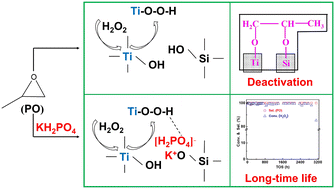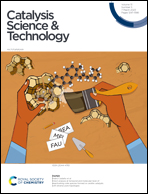Chemical deactivation of titanosilicate catalysts caused by propylene oxide in the HPPO process†
Abstract
The deactivation behavior of titanosilicates is the basis and key to developing high-performance epoxidation catalysts. Herein, we present an intensive study on the deactivation mechanism of titanosilicates in the HPPO process. In addition to the generally accepted physical deactivation of titanosilicates caused by pore blocking, we found that PO also chemisorbs on Ti–OH and adjacent Si–OH (Si–OH (Ti)) groups in titanosilicates under the induction of the Brønsted acid sites, forming bidentate ether species. Combining XPS, 13C solid-state MAS NMR, in situ FT-IR, and BET technologies, we confirmed that the bidentate ether species lead to selective chemical deactivation of Ti active sites. The Brønsted acid sites are associated with the formation of bidentate ether species, and their influence decreased in the order Ti–OOH > Si–OH (Ti) > Ti–OH. By introducing an appropriate amount of KH2PO4 in the Ti-MWW/H2O2 system, both shielding Si–OH (Ti) acid centers by ion exchange and stabilizing the reactive intermediate Ti–OOH by H-bond interactions to suppress Brønsted acid catalysis, a highly efficient and super long-lifetime HPPO process (H2O2 conversion >99%, PO selectivity >99.9%, lifetime >3000 h) was achieved, which is significantly more than 75 h reported in the literature. This finding clarifies that the chemical deactivation of titanosilicates caused by PO in the HPPO process is key to determining its long-period stable operation, which will guide the design and development of high-performance titanosilicate catalysts.



 Please wait while we load your content...
Please wait while we load your content...